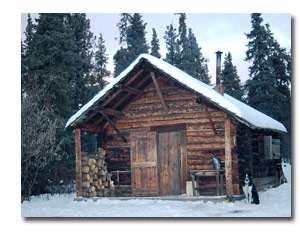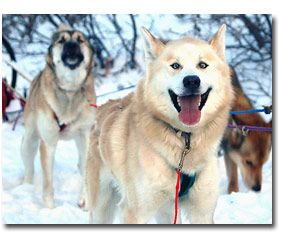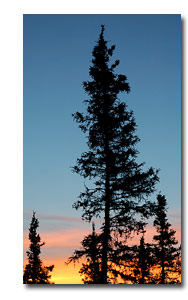Denali National Park Kennels: Preserving Alaska’s Cultural and Natural HistoryText copyright Tricia Rodriguez. Photography copyright Brad Ogle. All rights reserved.
"Whoa guys, take a break!" I called to my six-dog team as we slowed in front of the Igloo Creek Ranger Cabin in Denali National Park. It was Christmas Eve, and our second day out on the trail. That morning, we’d left from the Savage River Cabin and mushed about twenty miles through spruce forest, over a mountain pass, and along the frozen Teklanika River. Although the sky was already dark, it was only 4:30 PM. After spending some time with each dog in my team and getting them situated for the night, I grabbed my sleeping bag and walked the short trail up to the cabin.
Carmen, the acting kennels manager, and Brad were already inside. After feeding the dogs, we grabbed our axes and a couple of empty buckets and walked down to Igloo Creek. Water is a precious commodity, and we spend quite a bit of time gathering
 and melting snow or ice when we’re out on patrols. Because ice melts faster and more efficiently than snow, it’s worthwhile to walk a little farther to collect it. So we each chose a spot, began chopping out ice chunks and filling our buckets. As a southern girl who’s not used to anything outside being frozen, this was pretty fun! Soon our buckets were full, and we laid on our backs on the frozen creek to watch Nature’s own Christmas light show. There were thousands of bright twinkling stars, several meteors that left sparkly trails across the sky, and a beautiful green auroral display. It was the most magical Christmas Eve I’ve had since I stopped believing in Santa Claus. Little did I know that another incredible gift awaited us the following morning.
and melting snow or ice when we’re out on patrols. Because ice melts faster and more efficiently than snow, it’s worthwhile to walk a little farther to collect it. So we each chose a spot, began chopping out ice chunks and filling our buckets. As a southern girl who’s not used to anything outside being frozen, this was pretty fun! Soon our buckets were full, and we laid on our backs on the frozen creek to watch Nature’s own Christmas light show. There were thousands of bright twinkling stars, several meteors that left sparkly trails across the sky, and a beautiful green auroral display. It was the most magical Christmas Eve I’ve had since I stopped believing in Santa Claus. Little did I know that another incredible gift awaited us the following morning.
Due to the Christmas holiday, we decided to sleep in a little, rest the dogs and spend some time around the cabin. So we fed the dogs around 9:30 AM and returned inside to begin cooking our own breakfast. A short time later, we heard the dogs begin barking and howling like crazy – not the normal barking and howling either. We ran down to the road as fast as we could throw on our jackets and boots, not sure what to expect. I reached the road first, saw nothing to the west, then looked east. It appeared that a line of our dogs had escaped and run up the road about 100 feet, so I jogged a few steps in their direction then suddenly stopped – I realized all three of our dog teams were still tied up.
As Brad came down behind me, I squatted behind a sled and counted – there were seven of them. A pack of wolves! They were looking at us very intently but without malice, as we stared back in awe. They were long-legged and very large, most of them about 140 lbs or more. Several had black fur with some gray around the face, while another was reddish-brown and looked very much like one of our dogs. It was a moment when time disappeared, as we each studied the other. It seemed to stretch into hours, yet when one of the wolves turned its head and began trotting away, it seemed to have lasted only a millisecond. One by one, the rest of the pack followed until only one of the black wolves remained. It gave us a last long look, then turned away and disappeared. This encounter was a Christmas present that none of us will ever forget!
The next day was back to work for us and the dogs. We had already broken over forty miles of trail in the park, and we planned to continue breaking trail for another 15-20 miles on this trip. The conditions we would face included deep snow, ice, wind, bumpy tundra, and a steep climb over Sable Pass – a typical day for the Denali National Park sled dogs and their mushers.
The sled dogs of Denali have been an integral part of the park for so long that they have become part of the resource, a cultural tradition worthy of protection in its own right. They are the only sled dogs in the United States that help protect a national park, and rangers have patrolled Denali with dog teams since 1921. At that time, their primary purpose was to discourage poachers from hunting the park’s newly protected wildlife, but sled dogs also made it possible for the rangers to patrol the park’s boundaries, record wildlife populations, and keep in touch with the nearby residents. In addition, during construction of the park road from 1923-1938, dog teams hauled logs and supplies for the road as well as the construction of patrol cabins throughout the park, which are still in use today. By 1936, the kennels had fifty dogs and fourteen puppies, and they became one of the most popular summertime attractions for visitors. The program was thriving, but the next decade had many changes in store for the kennels.
As the United States entered World War II, airplanes and other mechanized vehicles began replacing dogs as the most common modes of transportation. Moreover, labor and budget shortages during the war years made it difficult to maintain an active sled
 dog kennel facility. Finally, by 1949, the last of the sled dogs was gone. Snow jeeps were used by the park service briefly in the 1950s, but mechanized equipment proved unreliable in the extreme temperatures and weather conditions that occur regularly in the park.
dog kennel facility. Finally, by 1949, the last of the sled dogs was gone. Snow jeeps were used by the park service briefly in the 1950s, but mechanized equipment proved unreliable in the extreme temperatures and weather conditions that occur regularly in the park.
In 1966, the National Historic Preservation Act was passed, which stated, “the historical and cultural foundations of the Nation should be preserved as a living part of our community life and development”. Sled dogs were already deeply rooted in the cultural history of interior Alaska, and it was clear that the dogs were more reliable and more adaptable to the park’s terrain, weather, and conditions than any mechanized vehicle. Therefore, when this mandate was issued, along with several other newly passed federal laws, it sparked the park administration’s interest in the kennels once again and provided an official rationale for their continued use. By the early 1970s, the dogs were once again a vital part of the park’s winter operations.
In 1980, the passage of the Alaska National Interest Lands Conservation Act (ANILCA) provided additional incentives for the use of sled dog teams. This act tripled the size of the park, and designated the original 2 million acre park as a wilderness area. According to the 1964 Wilderness Act, wilderness is “an area where the earth and its community of life are untrammeled by man, where man himself is a visitor who does not remain.” The legislation, in accordance with this main idea, also restricted the use
 of motorized equipment and mechanized vehicles. So traveling by dog team during the winter months provided rangers with the perfect way to continue their work by means that were consistent with the spirit of ANILCA and the Wilderness Act.
of motorized equipment and mechanized vehicles. So traveling by dog team during the winter months provided rangers with the perfect way to continue their work by means that were consistent with the spirit of ANILCA and the Wilderness Act.
Today, Denali’s sled dogs remain busy throughout the entire year. In the summer, attendance at the daily sled dog demonstrations totals over 50,000 visitors annually. The wintertime, however, is when the dogs prove that they are the heart of a tradition. On average, 3,000 patrol miles are logged throughout the park’s interior each winter – every single mile on the back of a sled pulled by our dogs. We are responsible for keeping a presence in the park - we break trails for local mushers, skijorers, and other winter recreationists to use. We then make contact with visitors that are using these trails, as well as report trail conditions, haul materials, assist park wildlife researchers with various projects, and keep an eye on the park’s boundaries. In order to achieve such a wide variety of tasks, we not only make long patrol trips into the backcountry, but we also run short day patrols on the trails closer to headquarters that visitors most commonly use. Such diverse responsibilities keep daily life interesting, and it is an honor to be part of the history here at the kennels. Not a day passes that I don’t appreciate the beauty of the landscape surrounding me, and my respect and love grows for the dog team lined out in front of me, ready and impatiently waiting for my command to run.
Back out on the trail, my dogs are running in front of me, and the only sounds I hear are the soft swooshing of the sled runners on the snow, the dogs’ feet trotting happily along the trail, and the occasional scolding of a Boreal Chickadee from a nearby spruce tree. I slow my team to a stop so we can take a short break. After hugging each dog and playing with them a bit, I stand up and walk back to my sled. Pausing for a brief moment, I take a deep breath of cold, fresh air and relish one of the very resources we are helping to protect – silence. It is a sweet sound in my ears. And then I step onto my sled, pull the snow hooks, and hang on tight..."Ready guys? Let’s go!"
Editor's note - to learn more about Brad and Tricia and their editorial contributions to NPN, read our Nature Photographers Network Sponsors Conservationists article.
Tricia Rodriguez - NPN 2177
Brad Ogle - NPN 2178
Comments on NPN habitat conservation articles? Send them to the editor.


| 


